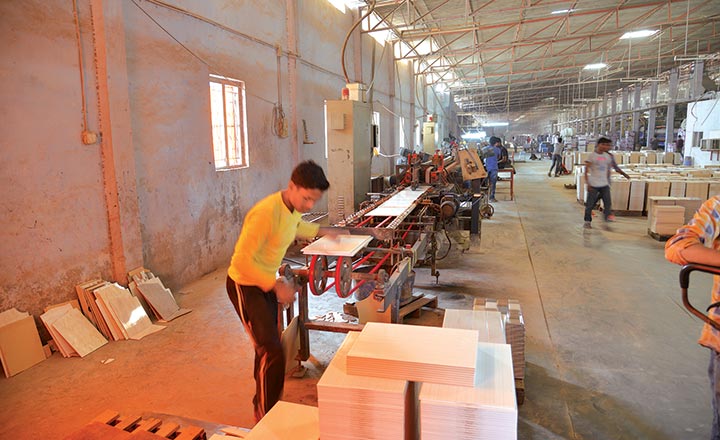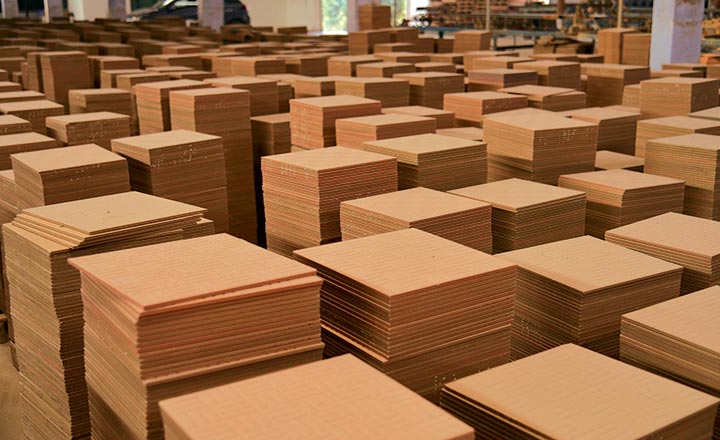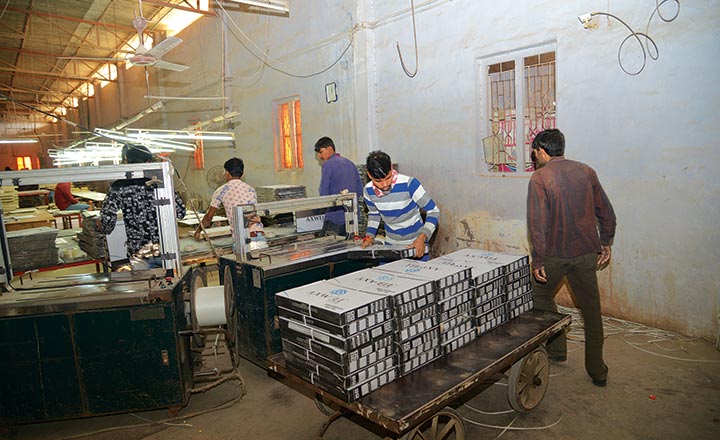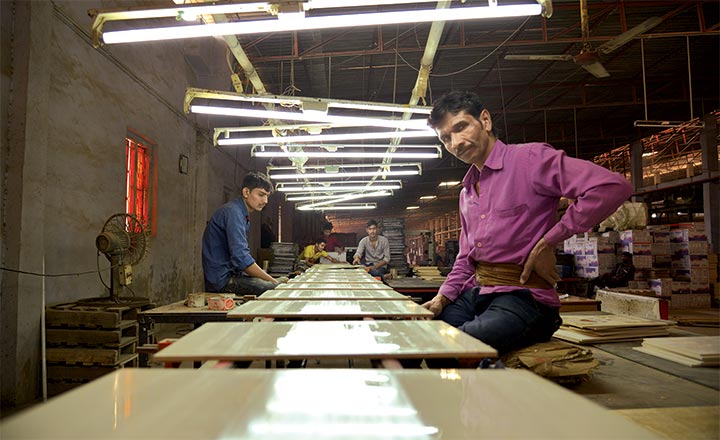Standing in front of a machine for a really long time, staring at it work and listening to the constant churr daka daka churr daka daka… might seem boring; but I couldn’t take my eyes off that humongous piece of technology dishing out perfectly cut, blocks of clay tiles in Airson Ceramic’s factory. There we were, an hour and a half away from the city of Rajkot, in Morbi, or as one might call it, ‘the paradise of ceramics’.
The cluster, known globally for its ceramic industry, currently consists of 610 units. Presently, Morbi employees about 350,000 factory workers and notched up a turnover of Rs.28,500 crore in FY17. It is now the third-largest manufacturing hub for ceramics in the world, and accounts for about 90% of the country’s total ceramic production. Last year alone, production was about 1,800 million sq mt and this year, the expected figure is 2,000 million sq mt. Morbi is a leading exporter — shipping to South East Asia, Europe and South America.
In the past year, one government policy that shook up the entire country was the implementation of the Goods & Services Tax (GST). Though every ceramic tiles vepari (businessman) in Morbi agree that a uniform tax system was long overdue, no one escaped its negative impact, in at least in the first three months — when demand was severely impacted. Although the reduction from 28% to 18% brought great relief, there are some issues that are yet to be resolved. KG Kundaria, president (vitrified tiles division), Morbi Ceramics Association, explains, “The central government was supposed to refund the excess tax amount within two months, and it’s been four months now, yet there is nothing. About Rs.3 crore of my own money is stuck,” he says. Kundaria is not the only one, there are many like him whose money is stuck with the government till date.

Joint effort
Businessmen in Morbi are a resilient lot. Over the past couple of years, they have managed to find a way to tackle all the curveballs that have been thrown at them. The last time we visited Morbi in 2015, the lull in the real estate market had dampened overall demand. The ceramic manufacturers also had to deal with an oversupply situation as there were a series of new entrants since 2012, lured by the growth that the industry had seen when the real-estate sector was in better shape.
Yet, most of the established players managed to overcome this problem either by exporting heavily or diversifying into new market segments or products. Exports have definitely come to their rescue clocking growth rates of about 30-40% over the past couple of years. And this year promises to be a good one as well. “We are hoping exports will increase from Rs.6,200 crore last year to Rs.10,000 crore by the end of this year,” says Kundaria. In November 2017, the Morbi Ceramic Association, decided to showcase the industry to countries across the globe by organising the Vibrant Ceramics Expo & Summit, which helped a lot of the smaller companies snag export orders.

Exports will continue to drive growth even as the real-estate market continues its slow recovery. Post-demonetisation in 2016, the real-estate sector took another knock with the implementation of RERA Act. So, ceramics manufacturers shifted their attention to government projects, individual housing in rural areas and smaller housing projects in tier-II and III towns. Ceramic manufacturers say that in rural areas and smaller towns, consumers are shifting to wall tiles, as they are proving to be more economical and a long-lasting alternative to paint. Bharat Aghara, joint managing director, Simpolo Group explains why, “Projects from private real estate companies were slowing down and our money would get stuck due to delayed payments.”
Aghara is one of the largest players in Morbi, whose company has an annual turnover of Rs.1,000 crore, and the shift in focus complemented the move into new product lines. “We needed to find a way out of the market’s slowdown. Our solution was to move into existing products like vitrified tiles and wall tiles and finding the right placement for them,” adds Aghara, who initially used to sell only sanitary ware. Thanks to a combination of all these efforts, overall industry revenue is likely to see an increase in FY18 to Rs.32,000 crore from Rs.28,500 crore in FY17.
Three years back, ceramic manufacturers, here,were also battling an influx of cheap imports from China. Imported tiles had made their way to markets in West Bengal, Orissa, Andhra Pradesh, Tamil Nadu, Kerala and Maharashtra causing significant losses for ceramic manufacturers in Morbi. However, with anti-dumping duty imposed in 2016, Morbi producers have got a leg up, at least in the domestic market.

In terms of exports, they continue to face competition from China but they are selectively pushing into countries that have imposed anti-dumping duty on China. According to Bharat Varmora, managing director, Varmora Granito, China is way behind India, especially in the vitrified tiles segment in terms of technology and product quality. In the case of technology, Morbi has always been a forerunner, investing in new machinery to improve productivity and design capability. “Every company has to upgrade its technology for manufacturing every five years, or it gets left behind. It is important we keep up with technological advancements and introduce new machinery wherever we can in order to improve efficiency,” says Hemal Patel, managing partner, Deepson Ceramics, who took the extreme step of shutting his plant down for three months to upgrade his production facility.
Power play
On one hand while ceramics manufacturers are doing everything they can to bolster demand, on the other hand, they are also working on tackling rising input prices. Ceramics is a power-intensive industry with natural gas and electricity accounting for 40% of total cost. Rising gas price has been a cause for distress, especially with Gujarat Gas (GGL) being the only supplier.In December 2017, there was a hike of Rs.2.50 per standard cubic meter (SCM) to be Rs.27.37 per SCM. “Gas is our core raw material to manufacture tiles, there is no other replacement for that. With GGL’s price fluctuations, we end up paying about Rs.15 lakh-Rs.25 lakh for gas, for about 15 days,” explains Jay Ambani, managing director, Airson Ceramic Industries, who is expecting his turnover to drop from Rs.19 crore last year to about Rs.15 crore-Rs.16 crore this year. The city consumes about three million SCM a day and because of the new rates, the industry will have to bear an additional burden of over Rs.1 crore on gas bill on a daily basis since they won’t be able to pass on the increase in costs immediately. Ravi Amrutiya, managing director, Sonex Plus Digital Floor Tiles, explains, “The price change happened in December last year. So while we can increase prices on our new orders starting January this year, but we can’t increase price for our existing orders on hand. We have to bear the brunt of the price hike on our existing orders.” Kundaria believes that a prior warning about price hike would help the industry a great deal. GGL, which provides piped natural gas (PNG) to over 3,000 industrial consumers across the state, was forced to increase prices given the steep 40% increase in international LNG prices. While natural gas has been a troublesome area for them, electricity supply in Morbi is no issue whatsoever barring the occasional power cut which the companies manage to tide over with the help of generators.
One of the options to avoid the price fluctuations of natural gas is to move to a coal-based gasifier, which is almost 20-25% cheaper. However, it can only be used when manufacturing wall tiles, not vitrified tiles. Till December 2013, 80% of Morbi’s tile manufacturers were using coal gas as the chief fuel in the manufacturing process. But, that led to a lot of pollution. This brought out a regulation that industries in Morbi could continue using coal gas so long as they reduced the emissions by 90% by incorporating the latest pollution-control technology in plants. One such company that is using coal gas since 2014 after getting the requisite approvals is Lexicon Ceramics. Their managing director, Narendra Sangath says using coal-based gas has helped them reduce their cost of production by 25%.

Bright future
In the recent Gujarat elections, Morbi was one of the most discussed constituencies where Congress won over BJP. The prevalent influence of Patidars led to the shift. “Moreover, infrastructure, especially roads and connectivity within the region is very poor. We pay massive taxes to the government, we have paid about 60% for these roads,” explains Amrutiya on the shift in party preference.
Although the cluster has its share of problems, players in the market are positive about resolving them in FY19. As far as future expectation goes, the cluster hopes GST’s ease of running business will reflect on their FY19 profitability. “We are glad there will be no more ‘C’ forms that need to be filled, and hopefully e-Way bill will make it a lot easier for us in the future,” adds Varmora. The cluster is also batting for a reduction in GST rates from 18% to 12%. As Morbi has had a tough couple of years and yet managed to survive them, the hope is one of an even brighter future.











